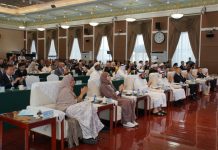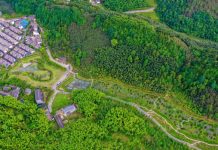ISLAMABAD: Extensive tourist facilities, especially in the Northern Areas, offer Pakistan an opportunity to attract Chinese tourists. This can not only help ensure a sustainable livelihood for the locals but also bring the much-needed foreign exchange to the country.
Managing Director of Pakistan Tourism Development Corporation (PTDC) Aftab ur Rehman Rana made the remarks while talking to media.
He said China and Pakistan were neighbouring countries with good diplomatic relationships, people-to-people contacts, and cultural exchanges.
“They are linked through air and land routes. Under the project ‘China-Pakistan Economic Corridor’ or CPEC, an improved infrastructure from Khunjerab to Gwadar is established. Further, the roads and highways linked with the CPEC provide not only trade and business opportunities but also make the tourists’ access to the tourist sites easier,” he said.
He said, “If we travel toward Gwadar, the tourist sites in Sindh, Balochistan, Punjab, Khyber Pakhtunkhwa (KP), and Gilgit-Baltistan (GB) can be reached. The main element in tourism is accessibility and the CPEC is making it possible. The next step is the development of boarding and lodging facilities all along, which will open up new opportunities for investors to develop new hotels and resorts. Many Chinese companies or individuals are even interested in coming and investing in developing tourism resorts in Pakistan.”
Aftab told media that the two governments held a dialogue on improving the tourist inflow. In 2023, he said, a number of meetings were held between the embassy officials on both sides, and a tour operator exchange program was also launched.
The Chinese operators visited their Pakistani counterparts and the PTDC officials visited Urumqi in Xinjiang. A plan to increase the flight frequency toward Urumqi and Kashgar is also under discussion.
He said, “Xinjiang is now a tourist hub in China with a well-developed infrastructure. It is expected that from 2024 onward, a better mechanism will lead to much better tourist traffic between Xinjiang and Gilgit-Baltistan (GB) through the Khunjerab border. The Pakistani government is working to improve the infrastructure facilities in GB. The Skardu airport has also been declared as an international airport and hopefully, very soon Urumqi and Skardu will be well-connected. On the same route, a tourist bus service is also part of the agenda to provide economic transport service to visitors from both sides.”
He said that there were a lot of cultural, language, food, and other social differences among the two countries. To bridge this gap and to make the communication better between the two nations, the PTDC has published a literature in the Chinese language explaining the tourist sites, local culture, facilities, and accessibility sources. A lot of digital material is also available in the Pakistani embassy in Beijing.
Speaking to media, Deputy Director of Tourism and Culture, Youth Affairs, Archaeology and Museums Department, GB, Sajid Hussain said, “The China-Pakistan Economic Corridor is a window of opportunity, especially for GB concerning tourism promotion. Karakoram Highway passes alongside Hunza, Gilgit, and Diamer districts covering around 1,000 kilometres. A lot of Chinese tourists visit here to enjoy the nature and adventure tourism. After the pandemic, the footfall of Chinese adventure tourists has been tremendous. Per annum, at least 80,00 to 10,000 Chinese tourists visit the region for adventure tourism”.
He said Gilgit-Baltistan region was full of unique landscapes and archaeological aspects to explore. The whole region is full of tourism potential and it is also a major source of livelihood. Much of tourism here revolves around eco and adventure tourism. Only 20 percent of the area has been discovered so far while the remaining 80 percent is still a panorama of exploration.
To date, Sajid said, at least 38,000 Buddhist inscriptions, carvings, and models have been explored while a great historical asset is still there to be digged out.
Sajid shared with media that after the snow melts (from May to the end of November), traders from Pakistan also visit China in good numbers to buy different products or to attend trade fares.
The GB tourism department coordinates them in this concern and business promotion activities get hiked across borders. The GB tourism department is working extensively to promote tourism-related activities in the region. But still, there is a need to work more with the coordination of all related provincial and federal departments to explore and showcase more hidden areas of the region. –INP






